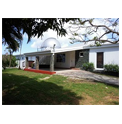On August 21st, 2017, the USVI will experience a solar eclipse. During the mid-afternoon on this day, the Earth’s Moon will pass directly between the Earth and the Sun, blocking out about 90% of the Sun’s surface as viewed from our vantage point in the USVI.
This eclipse has been called the “Great American Eclipse” in popular media due to the fact that a total eclipse of the Sun (in which the entire Sun, 100%, is blocked by the Moon) will be visible from a 70- mile wide path that stretches all across America, beginning in Lincoln City Oregon, crossing the U.S. mainland throughout the day on August 21st, and last being visible on the continent in Charleston, South Carolina. The last time a total solar eclipse was visible to such a large portion of the U.S. was 100 years ago. While the USVI are not within this so-called “path of totality”, we are quite close (it passes about 150 miles northeast of St. Thomas) and so we will see most of the Sun blocked by the Moon. The last time a solar eclipse passed so close to the USVI was 19 years ago.
It is extremely important to be aware that looking directly at the Sun without eye protection (even when it is partially eclipsed) can damage your eyesight. Looking at the Sun through binoculars or a telescope, even during an eclipse, will cause permanent eye damage, and possibly blindness.
UVI’s Etelman Observatory and UVI’s Physics program students and faculty will be hosting an eclipse-viewing event on August 21st from 1p-5p at UVI’s Sports and Fitness Center on St. Thomas. On St. Croix, an eclipse-viewing event will be held at the Research and Technology Park (RTPark) on the UVI Albert A. Sheen campus. UVI has been designated as the only Official NASA Viewing Location for the eclipse in the Caribbean. If you intend to view the solar eclipse on August 21st, we strongly encourage you to visit us at this event. Telescopes will be set up in the UVI soccer field (behind the Sports and Fitness Center) and UVI Physics and Astronomy faculty and students will be on-hand with proper eye-protection to make viewing the eclipse a safe and exciting experience for all. We will have a limited supply of solar-eclipse glasses as well as special solar-telescopes (designed for viewing the Sun safely) and other telescopes equipped with special protective filters to allow safe viewing of the Sun. We will also be demonstrating the use of pinhole cameras and telescope-projection techniques for viewing the eclipse indirectly (by casting an image of the Sun on a screen rather than viewing it directly with your eye). We also will send members of the Etelman Observatory Solar Physics research team and UVI physics students to the path of totality in Charleston, South Carolina. These researchers will be live-streaming video of the moment of total-eclipse from Charleston (2:47pm). Visitors to UVI will be able to watch the total eclipse by video on a large-screen set up in the UVI Sports and Fitness Center (weather permitting in Charleston, SC).
In St. Thomas, the eclipse will begin at 2:14p, when the Moon will just begin to block out the edge of the Sun. The eclipse will reach its maximum in the USVI (when about 90% of the Sun will be blocked out) at 3:36p, and from that point, the Sun will become less and less obscured until the Moon completely unblocks the Sun, at 4:47p.
If you have any questions or would like further information about joining us for this exciting event at UVI on August 21st, please contact Professor David Morris of the UVI physics program and Etelman Observatory (dmorris@uvi.edu). Also, please visit NASA’s Official Eclipse Viewing Location Map for more information about our event and others taking place around the country.


